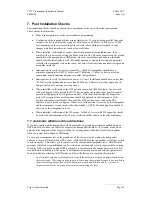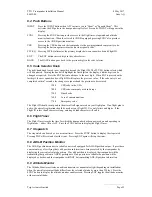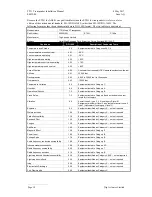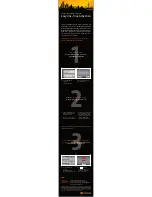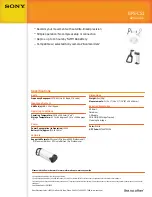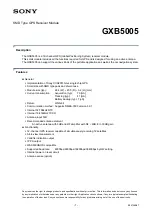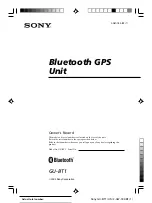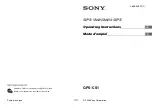
TT31 Transponder Installation Manual
8 May 2017
00455-00
Issue AQ
______________________
Trig Avionics Limited
Page 15
5.7 Interface Details
5.7.1
Power Input
The power supply can be 11-33 Volts DC; no voltage adjustment is required. Contacts 11 and 12 on
the 24 way connector are both available as power inputs. This is for compatibility reasons only –
internally the two are connected together, and in most installations only one need be connected to the
power supply.
Use a 3 Amp or greater circuit breaker for power supply protection to the TT31.
5.7.2
Lighting Bus Input
The TT31 will adjust the brightness of the front panel switch lighting according to the voltage on the
lighting bus input. Two lighting bus inputs are provided on the 24 way connector to accommodate
aircraft with 14 Volt or 28 Volt lighting systems. When the lighting bus operates at 28 Volts, connect
the bus input to contact 3, and leave contact 2 unconnected. When the lighting bus operates at 14
Volts, connect the bus input to contact 2. In this case contact 3 can be left unconnected, but for
backwards compatibility may also be grounded instead with no effect.
If no lighting bus input is detected, the TT31 will automatically control the front panel lighting based
on the ambient light sensor.
5.7.3
Mutual Suppression
Mutual suppression allows two or more transmitters on adjacent frequencies to inhibit the other
transmitters when one is active to limit the interference effects. It is commonly used between
transponders and DME systems, and between transponders and collision avoidance systems.
The TT31 provides two styles of mutual suppression interface on the 24 way connector. The Suppress
input on contact 9 is typically used in aircraft with simple DME systems and no other suppression
requirements. It is an input only, and is active whenever the input is greater than approximately 5
Volts.
The Suppress I/O on contact 4 is an ARINC compatible suppression bus interface, which acts as both
an input and an output. The TT31 will assert this signal when it is transmitting, and can be suppressed
by other equipment that asserts the signal. The TT31 will drive approximately 24 Volts on the output
(independently of supply voltage), and will treat the input as active whenever the bus has greater than
10 Volts.
5.7.4
Serial Port Options
There are two RS232 serial input/output ports, one on the primary connector (pins 6 and 7) and one on
the secondary connector (pins 2 and 3). The input sources can be an altitude encoder, air data
computer, or GPS for ADS-B support. The output can be serial altitude data for baro-aided GPS
devices, or TIS traffic for suitable display.
Note: although each input and output can be assigned separately, the line speed for each input
and output pair can only be set together.
5.7.5
Altitude Inputs and Output
The TT31 can use either a parallel Gray code altitude input, or serial RS232 altitude input. The Gray
code interface is on the 24 way connector, whereas the serial altitude can be configured to be on either
of the two RS232 inputs. If the altitude encoder you are using offers both, we recommend using the
RS232 serial input. Serial formats allow a higher resolution altitude representation that can be used by
Mode S interrogations, whereas parallel Gray code format can only represent altitude to the nearest 100
feet. You must choose between serial or parallel formats – you should NOT connect both. If a parallel
encoder is connected the TT31 will always use that as the altitude source even if a serial encoder is also
connected.
The parallel encoder inputs are active when the voltage to ground is pulled below approximately 4
Volts. The TT31 includes internal isolation diodes which prevent the unit from pulling the encoder
Содержание TT31
Страница 2: ...This page intentionally left blank ...























